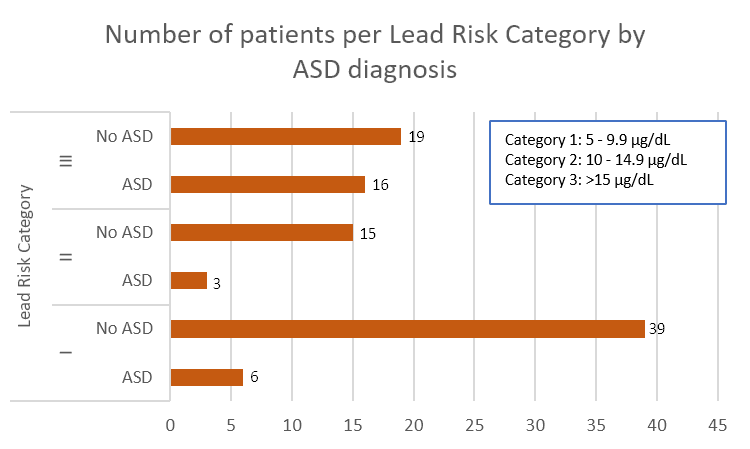Environmental Health
Category: Abstract Submission
Environmental Health I
122 - Autism and Lead Poisoning: A Case for Increased Screening in a Vulnerable Population
Friday, April 22, 2022
6:15 PM - 8:45 PM US MT
Poster Number: 122
Publication Number: 122.108
Publication Number: 122.108
Rajapillai L. Pillai, UMass-Chan Baystate, Springfield, MA, United States; Maria Covington, Columbia Memorial Health - Pediatrics, Selkirk, NY, United States; Paul F. Visintainer, UMMS - Baystate, Springfield, MA, United States; Hilary Branch, Baystate Children's Hospital, Springfield, MA, United States

Rajapillai L I Pillai, MD, PhD
Resident Physician
UMass-Chan Baystate
Springfield, Massachusetts, United States
Presenting Author(s)
Background: Lead exposure can cause neurocognitive problems in childhood and preventive screening can help limit these effects. There has been some evidence that children with autism spectrum disorder (ASD) may have a higher risk of lead exposure, though there is conflicting evidence in the literature.
Objective: Our study aims examine venous lead levels in patients with and without ASD in a community sample.
Design/Methods: In a cross-sectional study from a large lead treatment program, we compared venous lead levels between children with and without an ASD diagnosis. We then stratified venous lead levels into risk categories and compared the number of children from each group per category.
Results: We found significantly higher mean lead levels in children with ASD (21.1 µg/dL, n = 25 vs. 12.1 µg/dL, n = 73, p = 0.001). When children were classified according to lead risk category, children with ASD were overrepresented in the highest, Level III risk category (43%, compared with 14% and 18% in Level I and II risk, respectively). There was a significant effect of diagnosis on risk category (p = 0.003), which held even when correcting for age and sex.Conclusion(s): Our findings could have implications for lead screening, including the use of an ASD diagnosis as a separate risk factor that would encourage more frequent lead screening and potentially at older ages.
CV_PillaiCV_Pillai_112421.pdf
Number of Patients per Lead Risk Category by ASD Diagnosis A larger percentage of patients with ASD have category 3 risk levels of lead (greater than 15 µg/dL) than levels 2 (10 to 14.9 µg/dL) or 1 (5 to 9.9 µg/dL) risk categories.
A larger percentage of patients with ASD have category 3 risk levels of lead (greater than 15 µg/dL) than levels 2 (10 to 14.9 µg/dL) or 1 (5 to 9.9 µg/dL) risk categories.
Objective: Our study aims examine venous lead levels in patients with and without ASD in a community sample.
Design/Methods: In a cross-sectional study from a large lead treatment program, we compared venous lead levels between children with and without an ASD diagnosis. We then stratified venous lead levels into risk categories and compared the number of children from each group per category.
Results: We found significantly higher mean lead levels in children with ASD (21.1 µg/dL, n = 25 vs. 12.1 µg/dL, n = 73, p = 0.001). When children were classified according to lead risk category, children with ASD were overrepresented in the highest, Level III risk category (43%, compared with 14% and 18% in Level I and II risk, respectively). There was a significant effect of diagnosis on risk category (p = 0.003), which held even when correcting for age and sex.Conclusion(s): Our findings could have implications for lead screening, including the use of an ASD diagnosis as a separate risk factor that would encourage more frequent lead screening and potentially at older ages.
CV_PillaiCV_Pillai_112421.pdf
Number of Patients per Lead Risk Category by ASD Diagnosis
 A larger percentage of patients with ASD have category 3 risk levels of lead (greater than 15 µg/dL) than levels 2 (10 to 14.9 µg/dL) or 1 (5 to 9.9 µg/dL) risk categories.
A larger percentage of patients with ASD have category 3 risk levels of lead (greater than 15 µg/dL) than levels 2 (10 to 14.9 µg/dL) or 1 (5 to 9.9 µg/dL) risk categories.